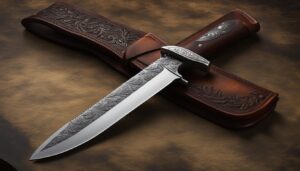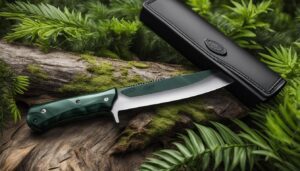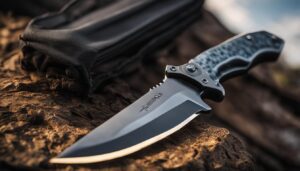Knife weight plays a crucial role in the performance and comfort of a hunting knife. Achieving the perfect balance is essential for optimal functionality and user satisfaction. A well-balanced knife offers superior control, maneuverability, and cutting efficiency. It also reduces strain and fatigue, enhancing overall stability and making every task easier. Different types of knives may require varying balances depending on their intended use, and personal preference also plays a significant role in selecting the ideal balance.
Key Takeaways
- The weight of a hunting knife significantly affects its performance and user comfort.
- A well-balanced knife provides greater control, maneuverability, and cutting efficiency.
- Testing the balance of a knife is done by placing a finger or thumb on the spine of the blade, just in front of the handle.
- Different knife types may require different balances based on their intended use.
- Personal preference also plays a role in choosing the ideal balance of a hunting knife.
The Importance of Balance in Knife Design
Achieving proper balance in knife design is crucial for optimal performance and user comfort. A well-balanced knife allows for greater control and maneuverability during use. It reduces strain and fatigue, provides stability, and enhances cutting efficiency.
The balance point should be located where the blade meets the handle, creating an even distribution of weight. Different knife types may have varying ideal balances depending on their intended use. Personal preference also plays a role, as some individuals may prefer a knife with a slight forward balance for added power, while others may prefer a more neutral balance for enhanced maneuverability.
When a knife is properly balanced, it becomes an extension of the user’s hand. It feels comfortable and natural to hold, making it easier to perform precise and controlled movements. This is particularly important for tasks that require intricate cutting techniques or prolonged use, such as filleting fish or preparing ingredients in a professional kitchen.
“A balanced knife is essential for maintaining control and efficiency in the kitchen. It allows me to confidently maneuver through different ingredients, creating clean and precise cuts. With a well-balanced knife, my work becomes more enjoyable and my results are consistently top-notch.”
Ultimately, the importance of balance in knife design cannot be overstated. It is a critical factor in determining the overall functionality and usability of a knife. Whether you’re a professional chef or an outdoor enthusiast, choosing a knife with the right balance can greatly enhance your performance and overall experience.
Table: Factors Affecting Knife Balance
| Factor | Description |
|---|---|
| Blade Material | The type of material used in the blade affects its weight, density, and overall balance. |
| Handle Ergonomics | The design and shape of the handle can contribute to the overall balance and comfort of the knife. |
| Craftsmanship | The quality of the knife’s construction and attention to detail can impact its weight distribution and balance. |
Factors Influencing Knife Balance
When it comes to achieving the perfect balance in a knife, several factors come into play. These factors greatly influence the weight distribution and overall balance of the knife, ultimately impacting its performance and user experience. Let’s explore some of the key factors that influence knife balance:
K1: Blade Material
The choice of blade material plays a significant role in determining the weight of the knife. Different materials have varying densities, resulting in knives of different weights. For example, stainless steel blades tend to be heavier compared to blades made from high-carbon steel. Knife makers carefully consider the properties of different materials to strike the desired balance between durability, sharpness, and weight.
K2: Handle Design and Ergonomics
The design and ergonomics of the handle also contribute to the overall balance of the knife. A well-designed handle should provide a comfortable and secure grip, allowing for easy control and maneuverability. The material, shape, and texture of the handle can all impact the weight distribution, with some designs favoring a more handle-heavy balance while others aim for a more blade-heavy balance.
K3: Craftsmanship and Weight Distribution
The craftsmanship of the knife is another crucial factor in achieving ideal balance. Expert knife makers carefully craft the blade and handle, meticulously shaping and balancing the knife to achieve optimal performance. They consider the weight distribution throughout the knife, ensuring that the balance point aligns with the junction of the blade and handle. This attention to detail and precision craftsmanship contribute to a well-balanced knife.
By taking into account these factors, knife manufacturers can create knives with different balances to suit various purposes and preferences. Whether you prefer a knife with a forward balance for added power or a neutral balance for enhanced maneuverability, understanding the factors influencing balance allows you to make an informed decision when selecting the right knife for your needs.
Choosing the Right Knife Weight for the Task
When selecting a knife, one of the key considerations is finding the right weight for the task at hand. The weight of the knife can significantly impact its performance and the overall experience of using it. Whether you’re a professional chef or a dedicated outdoorsman, choosing the right knife weight is essential to ensure optimal results.
When it comes to selecting the right weight, it’s crucial to consider the specific purpose of the knife. Different types of knives excel in different tasks, and the weight plays a significant role in their functionality. For example, a heavier knife may provide more power and stability, making it suitable for tough cutting jobs like chopping through bone or dense vegetables. On the other hand, a lighter knife may offer improved maneuverability and precision, making it ideal for delicate tasks such as filleting or slicing thin cuts of meat.
Personal preference also comes into play when choosing the right knife weight. Some individuals may prefer the heft and solid feel of a heavier knife, while others may find a lighter knife more comfortable for prolonged use. It’s essential to consider your own comfort and handling preferences to ensure a knife that feels natural and enjoyable to use.
| Type of Knife | Ideal Weight |
|---|---|
| Chef’s Knife | 8-10 ounces |
| Paring Knife | 3-4 ounces |
| Boning Knife | 6-8 ounces |
| Bread Knife | 10-12 ounces |
To help you make an informed decision, here’s a table outlining the ideal weight range for different types of knives commonly used in the kitchen:
Remember, this table provides general guidelines, and individual preferences may vary. It’s essential to try out different knives and weights to determine which feels most comfortable and effective for you. Before making a purchase, consider visiting a local kitchen supply store where you can handle and test various knives to find the perfect weight for your needs.

Summarizing the Key Points:
- Choosing the right knife weight is crucial for optimal performance and user comfort.
- The weight of the knife depends on the specific task at hand and the type of knife.
- Consider personal preferences and handling comfort when selecting the ideal knife weight.
- Try out different knives and weights to determine what feels most comfortable for you.
- Remember to test the balance of a knife by placing a finger or thumb on the spine to ensure optimal balance.
Conclusion
The impact of knife weight on performance, user comfort, and cutting efficiency is undeniable. Achieving the perfect balance is essential for optimal functionality. A well-balanced knife provides greater control, reduces strain and fatigue, enhances stability, and ensures smooth cutting motions.
When selecting a hunting knife, it is important to consider its balance along with other factors. Different knife types may require varying balances depending on their intended use. Personal preference also plays a role in choosing the ideal weight.
In summary, the weight of a knife has a significant impact on its overall performance. The balance point should be located where the blade meets the handle, creating an even distribution of weight. When testing the balance, place a finger or thumb on the spine of the blade, just in front of the handle. If the knife feels evenly balanced and doesn’t tip forward or backward, it indicates good balance.
Consider the weight of the knife alongside factors such as blade material, handle ergonomics, and craftsmanship to find the perfect tool for your needs. Ultimately, the right knife weight will enhance your hunting experience and ensure you can tackle any task with ease.
FAQ
Why is knife weight important in hunting knives?
Knife weight is crucial in hunting knives as it affects performance and user comfort. The right balance allows for greater control, reduces strain and fatigue, and improves cutting efficiency.
How can I test the balance of a knife?
You can test the balance of a knife by placing a finger or thumb on the spine of the blade, just in front of the handle. If the knife feels evenly balanced and doesn’t tip forward or backward, it indicates good balance.
Do different knife types require different balances?
Yes, different knife types may require varying balances depending on their intended use. For example, a chef’s knife may benefit from a slight forward balance for rocking motions, while a fillet knife may have a more rearward balance for better precision.
What factors influence the balance of a knife?
Blade material, handle ergonomics, and overall craftsmanship are important factors that influence the balance of a knife. The weight distribution throughout the blade and handle determines the overall balance.
How do I choose the right knife weight for a specific task?
The right knife weight depends on the specific task at hand. Consider the intended use of the knife and personal preference. For example, a chef’s knife may benefit from a slight forward balance, while a fillet knife may have a more rearward balance.





